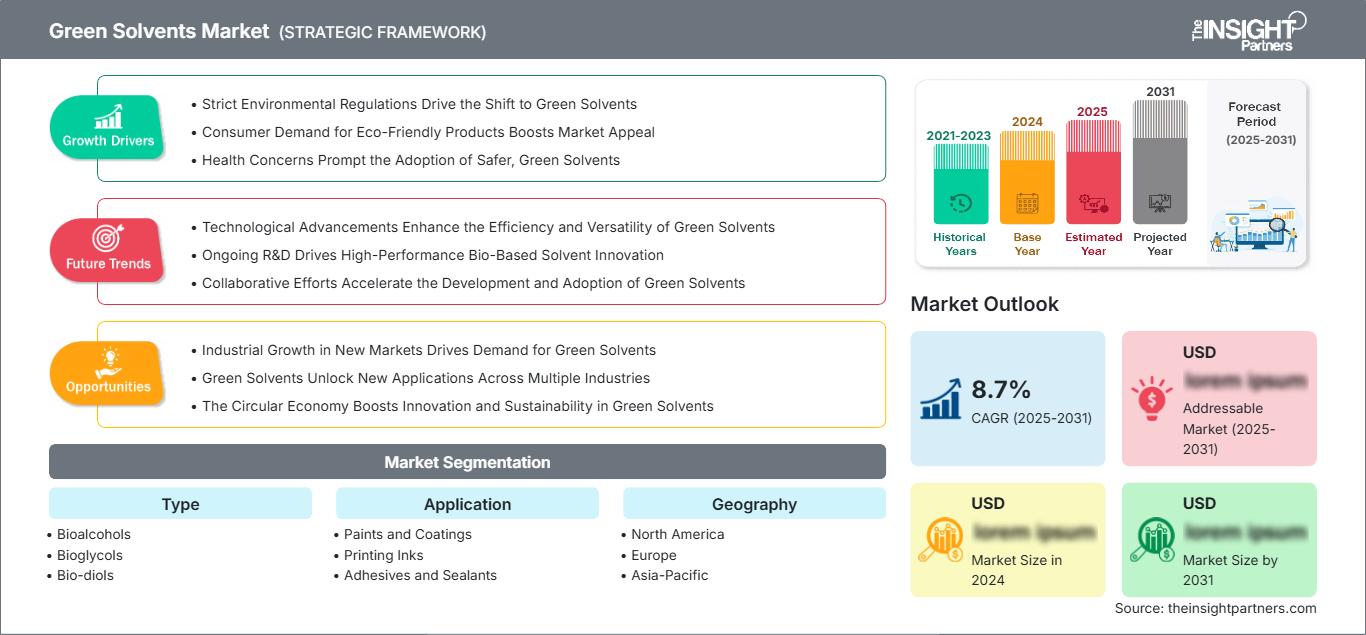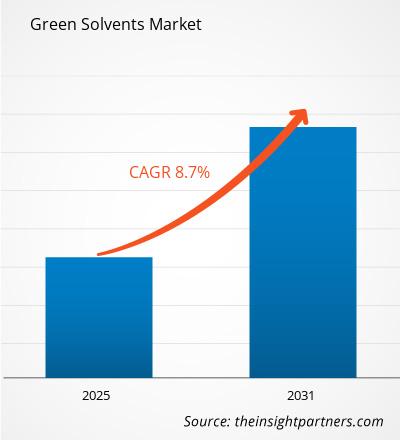Si prevede che il mercato dei solventi verdi raggiungerà i 3,7 miliardi di dollari entro il 2031. Si prevede che il mercato registrerà un CAGR dell'8,6% nel periodo 2025-2031.
Il rapporto è segmentato per tipologia (bioalcoli, bioglicoli, biodioli, D-limonene, esteri lattici, solato di metile e altri). Il rapporto presenta inoltre un'analisi basata sull'applicazione (vernici e rivestimenti, inchiostri da stampa, adesivi e sigillanti, cosmetici, prodotti farmaceutici, agricoltura, prodotti per la pulizia e altri). L'ambito del rapporto copre cinque regioni: Nord America, Europa, Asia-Pacifico, Medio Oriente e Africa, America Meridionale e Centrale e i principali paesi di ciascuna regione. L'analisi globale è ulteriormente suddivisa a livello regionale e per paesi principali. Il rapporto offre il valore in USD per l'analisi e i segmenti sopra indicati.
Scopo del rapporto
Il rapporto "Green Solvents Market" di The Insight Partners mira a descrivere il panorama attuale e la crescita futura, i principali fattori trainanti, le sfide e le opportunità. Ciò fornirà spunti a vari stakeholder aziendali, come:
- Fornitori/Produttori di tecnologia: per comprendere le dinamiche di mercato in evoluzione e conoscere le potenziali opportunità di crescita, consentendo loro di prendere decisioni strategiche informate.
- Investitori: per condurre un'analisi completa delle tendenze in merito al tasso di crescita del mercato, alle proiezioni finanziarie di mercato e alle opportunità esistenti lungo la catena del valore.
- Organismi di regolamentazione: per regolamentare le politiche e le attività di controllo sul mercato con l'obiettivo di ridurre al minimo gli abusi, preservare la fiducia degli investitori e sostenere l'integrità e la stabilità del mercato.
Tipo di segmentazione del mercato dei solventi verdi
- Bioalcoli
- Bioglicoli
- Biodioli
- D-limonene
- Esteri lattati
- Solato di metile
Applicazione
- Vernici e rivestimenti
- Inchiostri da stampa
- Adesivi e sigillanti
- Cosmetici
- Prodotti farmaceutici
- Agricoltura
- Prodotti per la pulizia
Potrai personalizzare gratuitamente qualsiasi rapporto, comprese parti di questo rapporto, o analisi a livello di paese, pacchetto dati Excel, oltre a usufruire di grandi offerte e sconti per start-up e università
Mercato dei solventi verdi: Approfondimenti strategici

-
Ottieni le principali tendenze chiave del mercato di questo rapporto.Questo campione GRATUITO includerà l'analisi dei dati, che vanno dalle tendenze di mercato alle stime e alle previsioni.
Fattori di crescita del mercato dei solventi ecologici
- Le rigide normative ambientali guidano il passaggio ai solventi ecologici: i governi hanno leggi ambientali severe e l'inquinamento e il cambiamento climatico devono essere eliminati. Questo costringe le industrie a ridurre il più possibile l'uso di solventi nocivi. Man mano che ciò diventa sempre più obbligatorio, le aziende optano per solventi ecologici nei loro prodotti per colmare le lacune e conformarsi ai requisiti.
- La domanda dei consumatori di prodotti ecocompatibili aumenta l'attrattiva del mercato: la consapevolezza dei consumatori è in crescita e la domanda di prodotti ecologici e rispettosi dell'ambiente è in aumento. I consumatori sono sempre più attratti dai marchi che considerano la responsabilità di prendersi cura dell'ambiente. Questa tendenza ha spinto i produttori a integrare solventi ecocompatibili nelle loro formulazioni per soddisfare i consumatori e migliorare l'attrattiva del mercato e la reputazione del marchio.
- Le preoccupazioni per la salute stimolano l'adozione di solventi più sicuri ed ecologici: la crescente consapevolezza dei rischi per la salute derivanti dall'uso di solventi tradizionali, tra cui problemi respiratori e irritazioni cutanee, ha spinto le aziende a ricercare soluzioni più ecocompatibili e meno pericolose. La maggior parte dei solventi ecologici rientra nella classificazione di non tossici e meno pericolosi; pertanto, questa rappresenta un'ottima opzione per le aziende che hanno a cuore la salute e il benessere dei propri dipendenti.
Tendenze future del mercato dei solventi ecologici
- I progressi tecnologici migliorano l'efficienza e la versatilità dei solventi ecologici: i progressi tecnologici trasformano il mercato dei solventi ecologici, consentendo ai solventi di origine biologica di raggiungere una migliore efficienza, efficacia e versatilità. Prestazioni migliorate, intervalli di applicabilità più ampi e potenziali riduzioni dei costi ne aumentano ulteriormente l'adozione, con aree di applicazione quali vernici, rivestimenti e prodotti farmaceutici.
- La continua attività di ricerca e sviluppo promuove l'innovazione dei solventi biologici ad alte prestazioni: ad esempio, i solventi ecologici richiedono ingenti investimenti in ricerca e sviluppo; un risultato costante è il miglioramento della formulazione e della funzionalità. Questa tendenza aumenta ulteriormente con la creazione di alternative ad alte prestazioni che soddisfano gli standard di settore. Un aspetto cruciale per sostenere le aziende è la ricerca e sviluppo volta a scoprire nuovi materiali biologici e a rafforzare la competitività sul mercato attraverso il miglioramento e l'innovazione in diversi settori.
- Gli sforzi collaborativi accelerano lo sviluppo e l'adozione di solventi ecologici: queste applicazioni di solventi ecologici sono ulteriormente supportate dall'intensificazione delle partnership industriali, accademiche e governative che contribuiscono ad accelerare lo sviluppo e l'adozione di solventi ecologici. Le partnership facilitano l'apprendimento reciproco e l'accumulo di risorse, rendendo possibile la commercializzazione di soluzioni innovative. Gli sforzi collaborativi sono emersi ulteriormente come vie per facilitare le opportunità di finanziamento e catalizzare il passaggio a pratiche sostenibili con lo sviluppo del mercato dei solventi verdi.
Opportunità di mercato per i solventi verdi
- La crescita industriale in nuovi mercati stimola la domanda di solventi verdi: la rapida crescita dell'industrializzazione in nuovi mercati può aprire enormi opportunità nell'utilizzo di solventi verdi. Le industrie regionali risponderanno alle severe normative ambientali adottando la sostenibilità, con una crescente richiesta di alternative più pulite. Le aziende possono trarre vantaggio da questa tendenza proponendo soluzioni innovative per i solventi verdi, su misura per le industrie locali e le preferenze dei consumatori.
- I solventi verdi aprono nuove applicazioni in molteplici settori: i solventi verdi aprono infinite nuove applicazioni in vernici e rivestimenti, prodotti farmaceutici e prodotti agrochimici. Mentre le aziende valutano il tipo di alternative sostenibili da adottare, il loro percorso potrebbe portarle a scoprire nuove applicazioni e formulazioni realizzate con solventi ecologici, ampliando ulteriormente la loro offerta di prodotti e penetrando in nicchie in cui consumatori e aziende si stanno concentrando su soluzioni più ecologiche.
- L'economia circolare stimola l'innovazione e la sostenibilità nei solventi ecologici: l'economia circolare offre nuove opportunità ai produttori di solventi ecologici, consentendo loro di sviluppare nuove opportunità creando nuove offerte orientate alla sostenibilità. Sebbene sia pensata per promuovere pratiche sostenibili, come il riciclaggio e la riduzione dei rifiuti, spinge le aziende ad avvicinare le proprie offerte a obiettivi ecologici più ambiziosi. Tale impegno avvicina queste aziende al miglioramento della reputazione del proprio marchio, all'attrazione di clienti attenti all'ambiente e all'innovazione nello sviluppo di prodotti sostenibili.
Mercato dei solventi verdi
Le tendenze regionali e i fattori che influenzano il mercato dei solventi verdi durante il periodo di previsione sono stati ampiamente spiegati dagli analisti di The Insight Partners. Questa sezione illustra anche i segmenti e la geografia del mercato della gestione delle malattie del ritmo cardiaco in Nord America, Europa, Asia-Pacifico, Medio Oriente e Africa, America meridionale e centrale.
Ambito del rapporto sul mercato dei solventi verdi
| Attributo del rapporto | Dettagli |
|---|---|
| Dimensioni del mercato in 2024 | US$ XX Billion |
| Dimensioni del mercato per 2031 | US$ 3.7 Billion |
| CAGR globale (2025 - 2031) | 8.6% |
| Dati storici | 2021-2023 |
| Periodo di previsione | 2025-2031 |
| Segmenti coperti |
By Tipo
|
| Regioni e paesi coperti |
Nord America
|
| Leader di mercato e profili aziendali chiave |
|
Densità degli operatori del mercato dei solventi verdi: comprendere il suo impatto sulle dinamiche aziendali
Il mercato dei solventi ecologici è in rapida crescita, trainato dalla crescente domanda degli utenti finali, dovuta a fattori quali l'evoluzione delle preferenze dei consumatori, i progressi tecnologici e una maggiore consapevolezza dei benefici del prodotto. Con l'aumento della domanda, le aziende stanno ampliando la propria offerta, innovando per soddisfare le esigenze dei consumatori e sfruttando le tendenze emergenti, alimentando ulteriormente la crescita del mercato.

- Ottieni il Mercato dei solventi verdi Panoramica dei principali attori chiave
Punti di forza
- Copertura completa: il rapporto analizza in modo esaustivo prodotti, servizi, tipologie e utenti finali del mercato dei solventi verdi, offrendo una panoramica olistica.
- Analisi degli esperti: il rapporto è redatto sulla base della conoscenza approfondita di esperti e analisti del settore.
- Informazioni aggiornate: il rapporto garantisce la pertinenza aziendale grazie alla copertura di informazioni e dati recenti.
- Opzioni di personalizzazione: questo rapporto può essere personalizzato per soddisfare le esigenze specifiche del cliente e adattarsi in modo appropriato alle strategie aziendali.
Il rapporto di ricerca sul mercato dei solventi verdi può quindi contribuire a guidare il percorso di decodificazione e comprensione dello scenario del settore e delle prospettive di crescita. Sebbene possano esserci alcune valide preoccupazioni, i vantaggi complessivi di questo rapporto tendono a superare gli svantaggi.
- Analisi storica (2 anni), anno base, previsione (7 anni) con CAGR
- Analisi PEST e SWOT
- Valore/volume delle dimensioni del mercato - Globale, Regionale, Nazionale
- Industria e panorama competitivo
- Set di dati Excel
Report recenti
Testimonianze
Motivo dell'acquisto
- Processo decisionale informato
- Comprensione delle dinamiche di mercato
- Analisi competitiva
- Analisi dei clienti
- Previsioni di mercato
- Mitigazione del rischio
- Pianificazione strategica
- Giustificazione degli investimenti
- Identificazione dei mercati emergenti
- Miglioramento delle strategie di marketing
- Aumento dell'efficienza operativa
- Allineamento alle tendenze normative






















 Ottieni un campione gratuito per - Mercato dei solventi verdi
Ottieni un campione gratuito per - Mercato dei solventi verdi